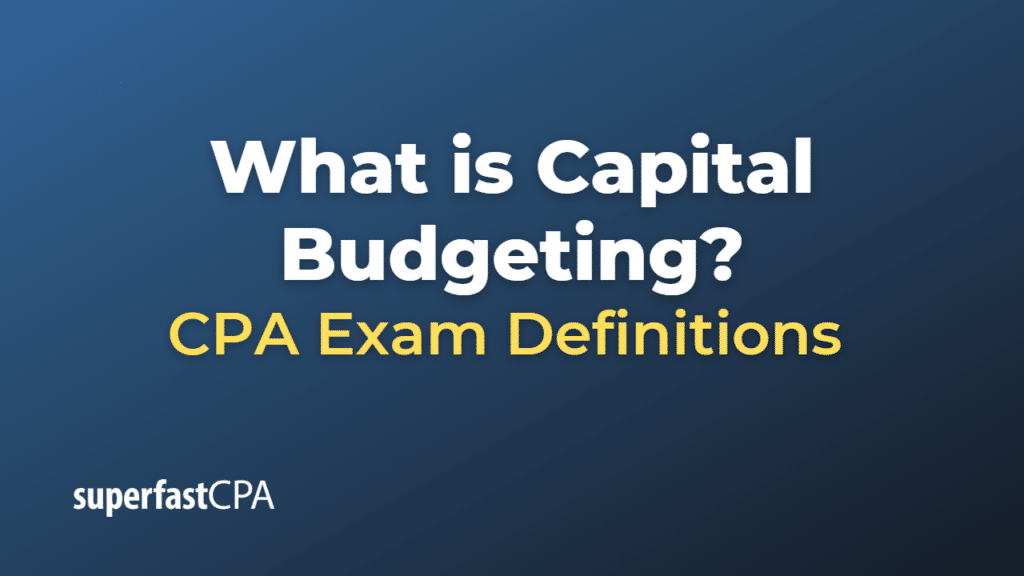Capital Budgeting
Capital budgeting, also known as investment appraisal, is the process by which a company or organization evaluates, prioritizes, and selects potential long-term investment projects based on their expected profitability, risk, and alignment with strategic goals. These projects typically involve significant financial commitments and are aimed at acquiring or upgrading capital assets, such as property, plant, equipment, or machinery, which are expected to generate revenue or improve operations over an extended period.
Capital budgeting involves the following key steps:
- Identifying potential investment projects: Management identifies potential projects that align with the company’s strategic goals and growth plans. These projects can include facility expansions, equipment upgrades, or new product development.
- Estimating future cash flows: For each potential project, the company estimates the expected cash inflows and outflows over the project’s life. This involves making assumptions about future revenues, costs, and other factors that may impact the project’s profitability.
- Evaluating projects: Management uses various techniques to evaluate and compare the profitability and risk of each potential project. Common methods include Net Present Value (NPV), Internal Rate of Return (IRR), Payback Period, and Profitability Index (PI).
- Selecting projects: Based on the evaluation, management selects the projects that best align with the company’s strategic goals and offer the most attractive risk-reward profile. This step often requires considering the company’s financial constraints, such as available funds, debt capacity, and risk tolerance.
- Implementing and monitoring projects: The selected projects are implemented, and their progress and performance are monitored regularly. This allows management to make necessary adjustments, such as reallocating resources or modifying project scope, to ensure the projects achieve their expected outcomes.
Capital budgeting is an essential aspect of a company’s financial planning and management, as it helps determine the most efficient allocation of resources to achieve long-term growth and profitability. Poor capital budgeting decisions can result in wasted resources, financial losses, and missed opportunities for growth.
Example of Capital Budgeting
Let’s consider a hypothetical example of a manufacturing company, “GreenTech,” which produces renewable energy equipment. GreenTech has identified three potential capital investment projects, but due to financial constraints, it can only undertake one of them at this time. GreenTech will use capital budgeting to evaluate and select the most suitable project.
The potential projects are:
- Expanding the existing manufacturing facility to increase production capacity (Project A).
- Investing in research and development for a new, more efficient solar panel technology (Project B).
- Upgrading the existing machinery to improve production efficiency and reduce energy consumption (Project C).
GreenTech follows these steps in its capital budgeting process:
- Estimating future cash flows: For each project, GreenTech estimates the expected cash inflows (e.g., additional revenue from increased production) and outflows (e.g., construction costs, R&D expenses) over the projects’ life.
- Evaluating projects: GreenTech uses Net Present Value (NPV) and Internal Rate of Return (IRR) methods to evaluate the profitability and risk of each project.
Assume the following NPV and IRR results:
- Project A: NPV = $1.5 million, IRR = 18%
- Project B: NPV = $2 million, IRR = 15%
- Project C: NPV = $1 million, IRR = 20%
- Selecting projects: GreenTech’s management considers the NPV, IRR, and strategic alignment of each project. While Project B has the highest NPV, it also has the lowest IRR and is riskier due to the uncertainties of R&D. On the other hand, Project C has the highest IRR but the lowest NPV. After considering their financial constraints, risk tolerance, and strategic goals, GreenTech’s management decides to undertake Project A, which offers a balance between profitability and risk.
- Implementing and monitoring projects: GreenTech begins the construction work to expand its manufacturing facility and regularly monitors the project’s progress and financial performance to ensure it stays on track and achieves the expected outcomes.
In this example, GreenTech uses capital budgeting to evaluate and prioritize its potential investment projects, ultimately selecting the one that best aligns with its strategic goals and offers an attractive risk-reward profile. This decision-making process helps GreenTech allocate its resources efficiently and pursue long-term growth and profitability.













